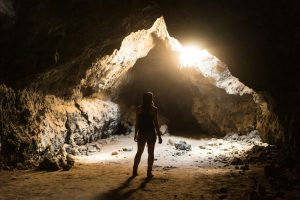Erica Trabold’s Five Plots is composed of five parts. The first, “Canyoneering” slowly introduces the reader to the story of Trabold’s extended family in short sections separated by sections of lyrical writing about caverns and canyons. Although the stories are told side-by-side in the chapter, the meaning behind their connection is not made very obvious. It took time for me to discover the ways in which they complemented each other.
Each time the chapter switches from one story/section to the next, a single asterisk in the middle of an empty line marks the change. I like this style choice because it makes the succeeding section feel like a footnote to its predecessor, in a continuous string of footnotes upon footnotes. The story builds on itself, and you have to do the work to consider how each part works together. One of the beauties of lyric essays is that they don’t offer all of the answers. So, in a sense, the real answer is whatever you come up with that makes sense and resonates with you.
“Canyoneering” begins with the sentence, “When I was a year old, my parents took me to see a cavern underneath New Mexico.” Trabold offers a little more detail about the trip, then ends the section with, “Tomorrow, they will introduce me to my biological grandfather for the first time.” Then, she talks about the ghosts and ancient histories held within rock and stone. She considers the first explorers of the cavern and their fearlessness. She imagines an explorer caught in stasis in the cavern for so long that she becomes a part of it and forgets herself. Trabold writes of herself, saying, “A nocturnal predator—the realization that I haven’t yet illuminated enough to live properly in the world—stalks me in every canyon, every cave of consciousness.” I underlined this sentence, but couldn’t quite connect it to the rest of the reading until later. In this chapter, Trabold explores her family history and the messy work of untangling it. As a baby, she visits this cavern and then meets her biological grandfather. As an adult, she returns, still feeling in the dark about her extended family. That darkness makes her wary, uneasy.
I also liked that sentence because it felt so immediately relatable. I can’t understand the specific struggles with untangling a family history, but I understand feeling lost due to a lack of knowledge about the world outside of myself. I dislike knowing that I don’t know something, and the inability to find answers can leave me floundering. Trabold’s ability to voice this through such a great metaphor helped me connect personally to the story. That’s what great writing does—connects us through our empathy and understanding of one another.